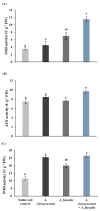Strategy of Salt Tolerance and Interactive Impact of Azotobacter chroococcum and/or Alcaligenes faecalis Inoculation on Canola (Brassica napus L.) Plants Grown in Saline Soil
- PMID: 33430173
- PMCID: PMC7825586
- DOI: 10.3390/plants10010110
Strategy of Salt Tolerance and Interactive Impact of Azotobacter chroococcum and/or Alcaligenes faecalis Inoculation on Canola (Brassica napus L.) Plants Grown in Saline Soil
Abstract
A pot experiment was designed and performed in a completely randomized block design (CRBD) to determine the main effect of two plant growth-promoting rhizobacteria (PGPR) and their co-inoculation on growth criteria and physio-biochemical attributes of canola plants (Brassica napus L.) plant grown in saline soil. The results showed that inoculation with two PGPR (Azotobacter chroococcum and/or Alcaligenes faecalis) energized the growth parameters and photosynthetic pigments of stressed plants. Moreover, soluble sugars' and proteins' contents were boosted due to the treatments mentioned above. Proline, malondialdehyde (MDA), and hydrogen peroxide (H2O2) contents were markedly declined. At the same time, antioxidant enzymes, viz. superoxide dismutase (SOD), ascorbate peroxidase (APX), and peroxidase (POD), were augmented due to the inoculation with Azotobacter chroococcum and/or Alcaligenes faecalis. Regarding minerals' uptake, there was a decline in sodium (Na) and an increase in nitrogen (N), potassium (K), calcium (Ca), and magnesium (Mg) uptake due to the application of either individual or co-inoculation with the mentioned bacterial isolates. This study showed that co-inoculation with Azotobacter chroococcum and Alcaligenes faecalis was the most effective treatment and could be considered a premium tool used in facing environmental problems, especially saline soils.
Keywords: antioxidant activity; canola; osmolytes; plant growth-promoting rhizobacteria; salinity.
Conflict of interest statement
The authors declare that there are no conflicts of interest related to this article.
Figures




References
-
- Machado R.M.A., Serralheiro R.P. Soil salinity: Effect on vegetable crop growth. Management practices to prevent and mitigate soil salinization. Horticulturae. 2017;3:30. doi: 10.3390/horticulturae3020030. - DOI
-
- Abdel Latef A.A.H., Srivastava A.K., El-sadek M.S.A., Kordrostami M., Tran L.P. Titanium dioxide nanoparticles improve growth and enhance tolerance of broad bean plants under saline soil conditions. Land Degrad. Dev. 2018;29:1065–1073. doi: 10.1002/ldr.2780. - DOI
-
- Abdel Latef A.A.H., Mostofa M.G., Rahman M.M., Abdel-Farid I.B., Tran L.-S.P. Extracts from yeast and carrot roots enhance maize performance under seawater-induced salt stress by altering physio-biochemical characteristics of stressed plants. J. Plant Growth Regul. 2019;38:966–979. doi: 10.1007/s00344-018-9906-8. - DOI
-
- Abdel Latef A.A.H., Alhmad M.F.A., Kordrostami M., Abo–Baker A.-B.A.-E., Zakir A. Inoculation with Azospirillum lipoferum or Azotobacter chroococcum reinforces maize growth by improving physiological activities under saline conditions. J. Plant Growth Regul. 2020;39:1293–1306. doi: 10.1007/s00344-020-10065-9. - DOI
-
- Jadhav G.G., Salunkhe D.S., Nerkar D.P., Bhadekar R.K. Isolation and characterization of salt-tolerant nitrogen-fixing microorganisms from food. EurAsian J. Biosci. 2010;4:33–40. doi: 10.5053/ejobios.2010.4.0.5. - DOI
Grants and funding
LinkOut - more resources
Full Text Sources
Other Literature Sources
Molecular Biology Databases
Miscellaneous

